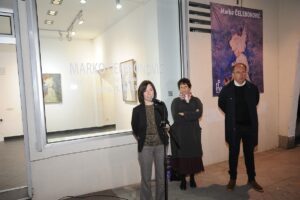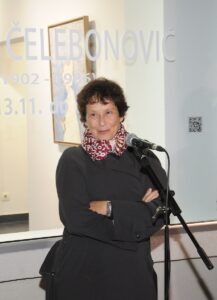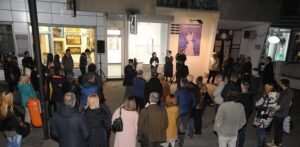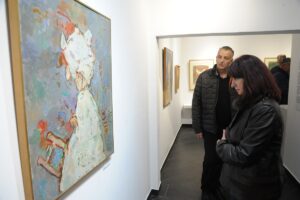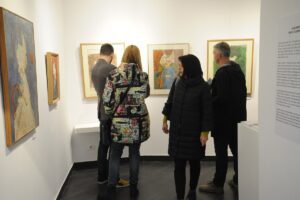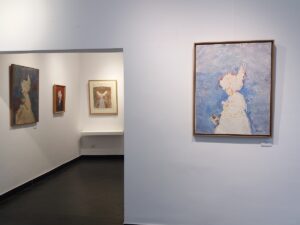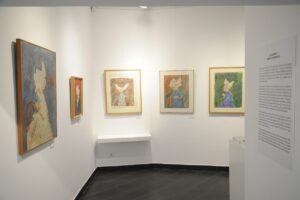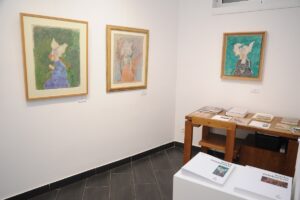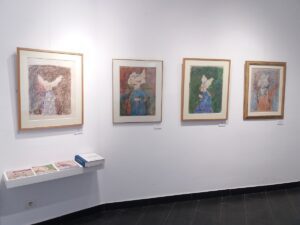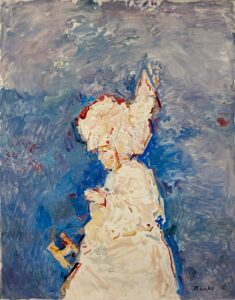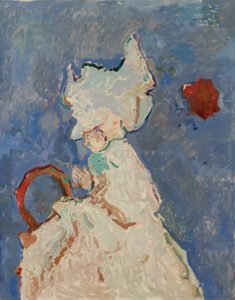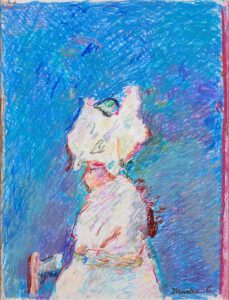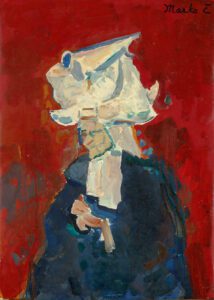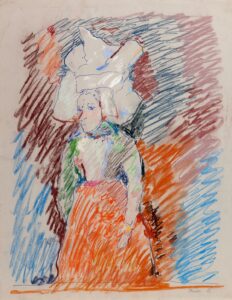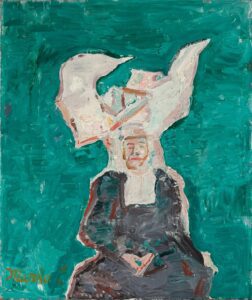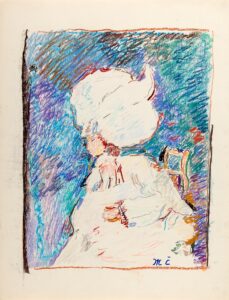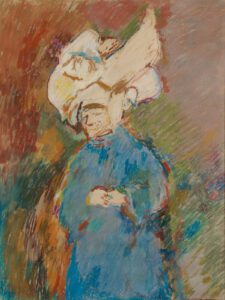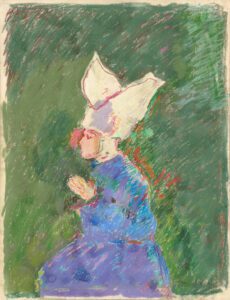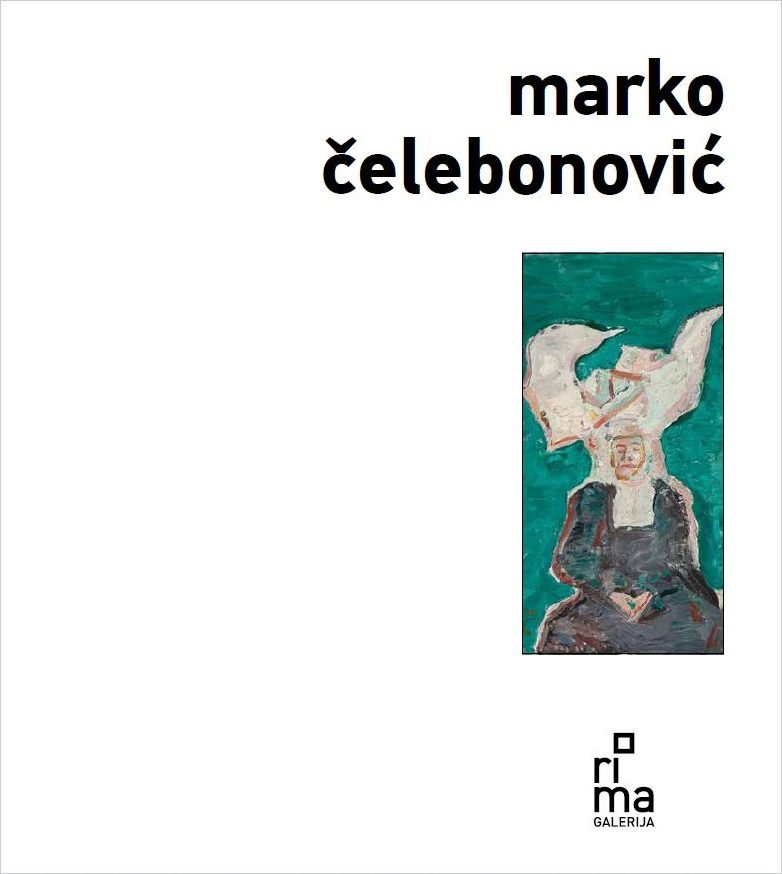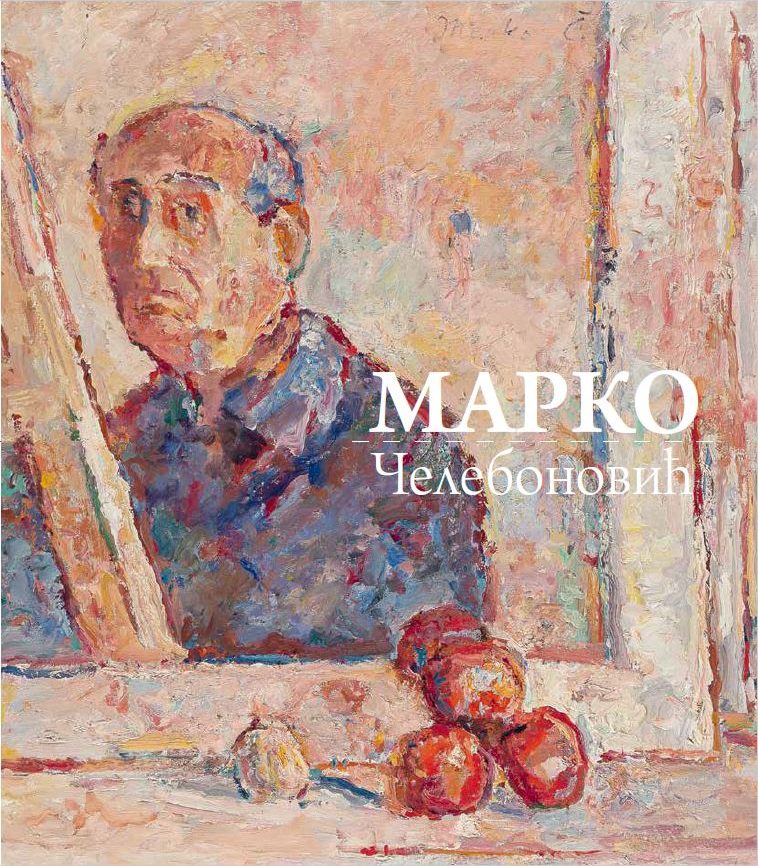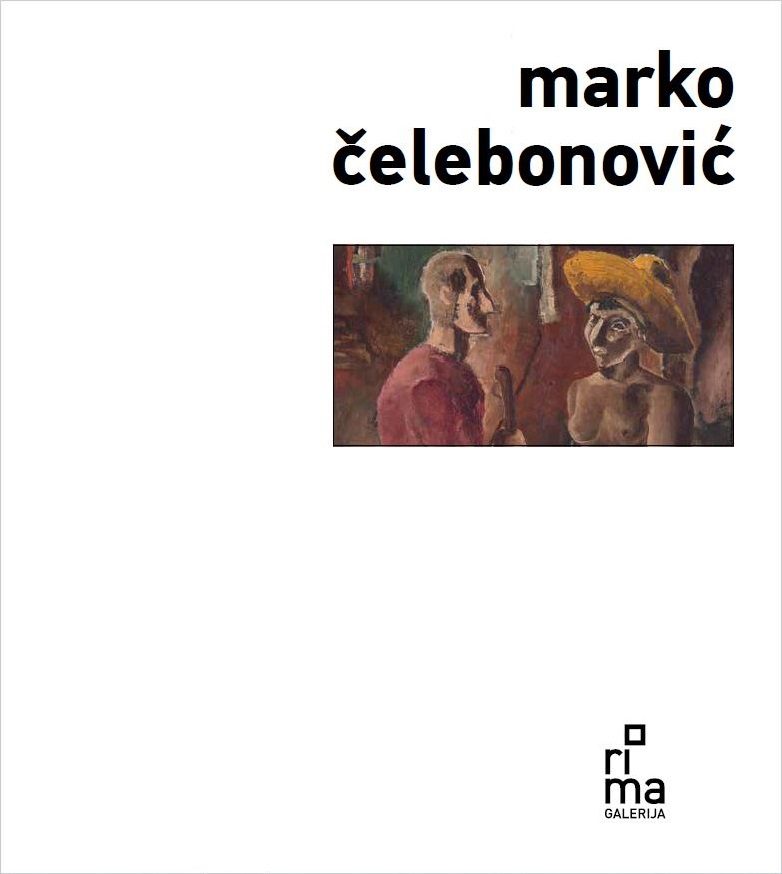13 November - 13 December 2018
Nevena Martinović
MARKO ČELEBONOVIĆ’S NUNS
According to their number and the time when they were produced, Nuns represent a short and almost unnoticeable episode in the long and rich creative life of Marko Čelebonović. Nevertheless, the role this modest cycle, made almost in a flash, had in the artist’s painterly evolution marks it as an irreplaceable phase in Čelebonović’s creative output.
The works with the motif of nuns were painted in the winter months between 1966 and 1967. The visual impulse were the figures of nuns from the Catholic monastery situated not far from Čelebonović’s studio in Avenue Danfert-Rochereau in Montparnasse. When he was in Paris, the artist could meet every day the passing-by nuns in long habits and with the traditional high head-gear in starched canvas (the so called cornets). Under a powerful inspiration of these scenes Čelebonović painted that winter a series of works in oil on canvas and pastel on paper.
He publicly presented a selection of Nuns for the first time already in 1968 and 1969 at three consecutive solo shows in Sarajevo, Split and Osijek.[1] The major part of these exhibits were pastels and only two paintings in oil – In Meditation and Penitent Nun, both from 1967. After having been exhibited in Sarajevo and Osijek the painting In Meditation (cat. no. 2) was purchased in 1972 by the Republican Cultural Fund for the National Museum in Kragujevac, where it is still kept. Penitent Nun remained in the artist’s collection and was exhibited at two solo shows in Belgrade, in 1972 and 1982.[2] There are no documentary records of that work after these exhibitions. However, since it was accessible for exhibiting in the last decades of Čelebonović’s life when his solo shows in Yugoslavia were organised by his brother Aleksa – one could logically suspect that it is the painting Nun (cat. n. 3) presently in the collection of Vladan Čelebonović, Aleksa’s son. Both paintings will be shown in Gallery RIMA at the first exhibition fully dedicated to Čelebonović’s cycle Nuns.
————————-
[1] Sarajevo, Art Gallery, Small Gallery, 16 April – 5 May 1968; Split, Art Gallery, May 1968; Osijek, Cultural Centre of the People’s University „Božidar Maslarić“, 1-23 October 1969
[2] Belgrade, Gallery of the Yugoslav Army Club, 12 October – 5 Novembeer 1972; Belgrade, Art Pavilion Cvijeta Zuzorić, 26 November – 19 December 1982.
The exhibition history of Nuns is primarily related to the pastels. Even eighteen pastels with this motif were shown for the first time at the exhibition in Sarajevo in 1968, and as soon as the following year they were the main exhibits at the solo show completely dedicated to his pastels. In 1973 and 1975 they were present at the remaining three exhibitions of pastels the artist organised during his lifetime, in Belgrade and Novi Sad.[1] By selecting the Nuns in the late sixties as the main deputies of his current work and by including them in the exhibitions held in the seventies, Čelebonović underlined their significant role in the direction he was following in his painterly research. Consequently, this cycle initiated the process of serious exhibition and theoretic evaluations of the pastels in the opus of Marko Čelebonović as they were previously marginally mentioned in the reviews of certain shows. Therefore, Nuns were posthumously shown at exhibitions of Čelebonović’s works, particularly at a few dedicated solely to his pastels and drawings.[2] The last in this series is the exhibition held in Gallery RIMA where it is possible to see the pastels from Čelebonović’s original selection shown much earlier – In Prayer (cat. no. 6), From the Niebelungen (cat. no. 8), Suspicious Nun (cat. no. 7).[3] In this exhibition, pastels are again combined with oil paintings in order to reconstruct a short period of the artist’s creative concentration that engendered a unique cycle within his output and contributed to the marking out of the direction in which his painting would move in the following fifteen years.
In order to understand correctly the change in Čelebonović’s picture visible in the Nuns cycle, it is important to remember three main characteristics of his painting. First, from the late twenties Marko Čelebonović was always painting from the motif, regardless of the subject matter such as still-lifes, models posing, interiors or landscapes. He did not make preparatory studies which he would subsequently use as patterns for his paintings, but created his pictures in séances on the spot, in front of the object of observation. The second characteristic is that each of his paintings comprises a virtuously balanced, but clear difference between the motif and the content, as the artist once pointed that out: “Apart from what is happening in the canvas and what can be described and analysed, there is a more or less intensive feeling – as if behind the curtain represented only by the surface of the canvas with its layers of forms and colours – that the main thing is happening behind, something vivid, deep and profound that bestows the artwork with a real dimension. In order to explain that, I shall use an example from music. I could say that behind the pyramid of sound lines and polyphonic complexities with Bach we feel that the main content of his musical meditation – the relationship of man and destiny – are his thoughts about life and death.”[4] In that context, the scene in front of which Čelebonović sets his easel, the scene he paints “after nature” is only a mediator of the contents the artist endeavours to express with visual means. The formal changes, visible in Čelebonović’s paintings for decades, emerged as parts of the process of his search for the best way to express “what is not, figuratively speaking, in the picture, but behind it”.[5] The third, essential feature of Čelebonović’s picture is that content, which the artist himself was able to recognise gradually as the only unchangeable constant of his picture and to define it as follows: “I have realised that the issue was always in the space and never in anything else.”[6] “Among the various planes of depth where we imagine certain elements in the picture, there is an exciting ratio of moving away, in fact the real content of our fascination with life. The rhythm between the size of objects, their matter and the way they increase distance between them, the conceptual and not photographic representation of those distances, for me that is the real subject matter of my picture.”[7] “That is the space we cannot either define, or prove, or describe, the space that we only feel and presume.”[8]
Relying on the observed scene, the artist always expressed his experience of the world, that poetic and infinitely personal, unspeakable feeling of life and existence, only indirectly. In search for the means of expressing the infinite space of thought, spirit, or feeling – of the universal being – by using the phenomenon of physical space and objects he perceives visually. This helped maintain the subtle balance between the presented and the expressed, the balance that was inherent to Čelebonović’s character and temperament. However, this kind of mediation brought along a clear limitation by framing the content which is boundless. He may have experienced space as a conceptual vibration, as poetry or music, as a feeling – but objects inevitably recalled to mind their objectness and imposed their physical boundaries.
Stojan Ćelić was the first to draw attention to the fact that Čelebonović did not paint Nuns in his usual manner and in that case he departed from the “work after nature”.[9] The nuns did not sit for the artist – he painted them after memory. Those female figures seen in passing, in long habits and with unfolding starched canvases on their heads, left visual imprints in the unstable space of artist’s memory. Even before the picture was realised those visual imprints had already been submerged into the spaces of the artist’s mind where they were permanently altered by his own experience. Without the presence of a model who would serve as visual concentration and a specific “anchor” in real environment, Čelebonović could rely only on his internal self. Therefore, when he painted the figures of nuns from Avenue Denfert-Rochereau, Čelebonović was directly transposing into the picture a nook of his internal ambience, a reflection of the mind, where the motif and the content met on the borderline of indivisibility.
The figures of the nuns are depersonalised and transformed into unique fantastic forms, in fluid forms created from light and air, unstable and scintillating, submerged into the space without coordinates. The space has been emptied of objects but it has been filled to saturation with the vibrations of Čelebonović’s own pulse. Instead with the air that envelops real objects, this space is filled with the “spiritual matter”[10] woven by the artist’s coloured gesture. “These surfaces are streaked with a net of strokes whose structure is not uniform […] and one can speak here of lines, of the net which does not represent a system, but is dictated by the rhythm, the impulse and is the reflection of that impulse, of that neuro-pulsific twitch of an exclusively subjective character, irrational and explainable only by the degree and intensity of that sensual vibration”.[11] Since the second half of the fifties the gesture in Čelebonović’s treatment of the painted surface was gradually becoming independent from the form. At first, the contour lines no longer had to follow their primary role, then the colouristic short linear accents were multiplied in relation to the wide coloured surfaces, so that in the early sixties the artist began to create his pictures solely from the nervatures of miniaturised strokes. An important role in this had Čelebonović’s engagement in the pastel and owing to its specific characteristics pastel imposed itself as the catalyst in the process of the reduction of the pigment layer to a linear trace.[12] Čelebonović was then more frequently finding within those strokes that made up the objects some openings for traces of colour as spontaneous twitches of a painterly instinct, with no justification in the painted forms. Therefore, when the model of observation disappeared completely, Čelebonović’s “nervatures-contours”[13] became the only possible carriers of what lies exclusively in the sphere of instinct, emotion, imagination and spirituality. Nuns were thoroughly created from those changeable twitches, from the feverish coloured layers of extraordinary harmonies that make the entire surface scintillate, depriving the figure and the space of the feeling of materiality and the burden of physical existence.
In his cycle of Nuns Čelebonović made an important step forward for which he had been preparing for years – the mediator between his existence and the picture had disappeared. The change was not reflected in the rejection of objects the artist used to like so much, it was in the possibility that their objectness could be neglected and discarded like a cocoon – so that the commode could become only the lower rhythm in space, so that it would no longer matter whether something was a still-life or a landscape. This made it possible for Čelebonović to transport, in his later pictures, all the most precious objects of observation in whose forms he had endeavoured to weave his own experience of the world – still-lifes, portraits, the house in Saint Tropez – into the spaces of pure spirit and make them one with his own self.
——————
[1] Belgrade, Gallery of the Association of Graphic Artists, 1–10. March 1973; Novi Sad, Small gallery, 26 October – 9 November 1973; Belgrade, Gallery Popović, December 1984 (drawings and pastels).
[2] Varaždin, Gallery Sebastian, 15 October – 10 November 1986; Belgrade, Zepter Museum, 13 April – 14 May 2017; Novi Sad, The Pavle Beljanski Memorial Collection, 19 April – 3 June 2018.
[3] Since numerous pastels known today only on the basis of the data from catalogues and there are no accompanying reproductions, one should not neglect the possibility that other pastels shown in Gallery RIMA might have been exhibited in Čelebonović’s lifetime.
[4] С. Пауновић, „Марко Челебоновић: кад ствара, сликар мора бити против свога времена” (M.Č.When a painter is creating, he should be against his time), Политика, Belgrade, 20 November 1966.
[5] Ibid.
[6] Д. Адамовић, „Ритам простора” (The rhythm of space), an interview with M.Č., Политика, Belgrade, 10 November 1974.
[7] М. Живковић, „Ствараоци и дела. Кажу ми да сам срећан”, an interview with M.Č (Artists and their works) Питика, Belgrade, 10 November 1974.
[8] D. Adamović, op. cit.
[9] С. Ћелић, Марко Челебоновић (M.Č.), САНУ, Југославија, Belgrade 1977.
[10] O. Švajcer, „Pasteli Marka Čelebonovića u Osijeku” (Pastels of M. Č. in Osijek), Revija, Matica hrvatska, IX, No. 6, 1969.
[11] Ibid.
[12] On the works by Marko Čelebonović in pastel, see: Nevena Martinović, „Pasteli Marka Čelebonovića: od odraza do oslonca stvaralačkog identiteta“ (The pastels of M. Č.: from reflection to the stronghold of creative activity), J. Denegri, et. al, Marko Čelebonović, Galerija RIMA, Kragujevac 2017.
[13] С. Ћелић, op.cit.
